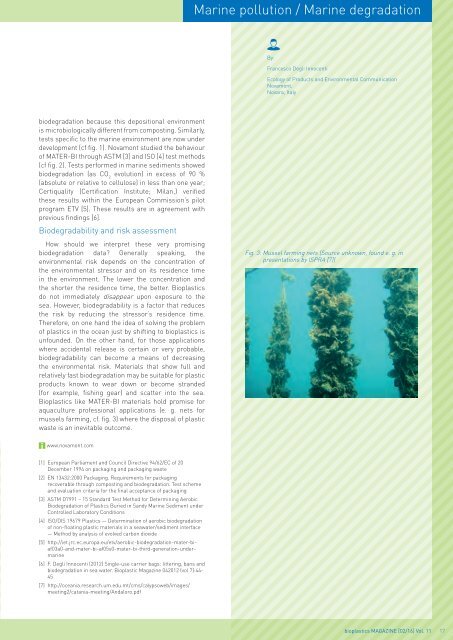Issue 02/2016
bioplasticsMAGAZINE_1602
bioplasticsMAGAZINE_1602
You also want an ePaper? Increase the reach of your titles
YUMPU automatically turns print PDFs into web optimized ePapers that Google loves.
Marine pollution / Marine degradation<br />
By:<br />
Francesco Degli Innocenti<br />
Ecology of Products and Environmental Communication<br />
Novamont,<br />
Novara, Italy<br />
biodegradation because this depositional environment<br />
is microbiologically different from composting. Similarly,<br />
tests specific to the marine environment are now under<br />
development (cf fig. 1). Novamont studied the behaviour<br />
of MATER-BI through ASTM [3] and ISO [4] test methods<br />
(cf fig. 2). Tests performed in marine sediments showed<br />
biodegradation (as CO 2<br />
evolution) in excess of 90 %<br />
(absolute or relative to cellulose) in less than one year;<br />
Certiquality (Certification Institute; Milan,) verified<br />
these results within the European Commission’s pilot<br />
program ETV [5]. These results are in agreement with<br />
previous findings [6].<br />
Biodegradability and risk assessment<br />
How should we interpret these very promising<br />
biodegradation data? Generally speaking, the<br />
environmental risk depends on the concentration of<br />
the environmental stressor and on its residence time<br />
in the environment. The lower the concentration and<br />
the shorter the residence time, the better. Bioplastics<br />
do not immediately disappear upon exposure to the<br />
sea. However, biodegradability is a factor that reduces<br />
the risk by reducing the stressor’s residence time.<br />
Therefore, on one hand the idea of solving the problem<br />
of plastics in the ocean just by shifting to bioplastics is<br />
unfounded. On the other hand, for those applications<br />
where accidental release is certain or very probable,<br />
biodegradability can become a means of decreasing<br />
the environmental risk. Materials that show full and<br />
relatively fast biodegradation may be suitable for plastic<br />
products known to wear down or become stranded<br />
(for example, fishing gear) and scatter into the sea.<br />
Bioplastics like MATER-BI materials hold promise for<br />
aquaculture professional applications (e. g. nets for<br />
mussels farming, cf. fig. 3) where the disposal of plastic<br />
waste is an inevitable outcome.<br />
Fig. 3: Mussel farming nets (Source unknown, found e. g. in<br />
presentations by ISPRA [7])<br />
www.novamont.com<br />
[1] European Parliament and Council Directive 94/62/EC of 20<br />
December 1994 on packaging and packaging waste<br />
[2] EN 13432:2000 Packaging. Requirements for packaging<br />
recoverable through composting and biodegradation. Test scheme<br />
and evaluation criteria for the final acceptance of packaging<br />
[3] ASTM D7991 – 15 Standard Test Method for Determining Aerobic<br />
Biodegradation of Plastics Buried in Sandy Marine Sediment under<br />
Controlled Laboratory Conditions<br />
[4] ISO/DIS 19679 Plastics — Determination of aerobic biodegradation<br />
of non-floating plastic materials in a seawater/sediment interface<br />
— Method by analysis of evolved carbon dioxide<br />
[5] http://iet.jrc.ec.europa.eu/etv/aerobic-biodegradation-mater-biaf03a0-and-mater-bi-af05s0-mater-bi-third-generation-undermarine<br />
[6] F. Degli Innocenti (2012) Single-use carrier bags: littering, bans and<br />
biodegradation in sea water. Bioplastic Magazine 042012 (vol 7):44-<br />
45<br />
[7] http://oceania.research.um.edu.mt/cms/calypsoweb/images/<br />
meeting2/catania-meeting/Andaloro.pdf<br />
bioplastics MAGAZINE [<strong>02</strong>/16] Vol. 11 17


















